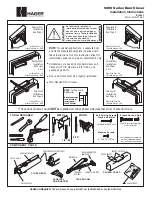
19
The manual torches can work in SHARK “M / MR” version
plants only if terminals 3 and 4 are short-circuited on the 14
pole male connector used to interface with the CNC control-
ler plants (Fig. P).
Code 460180: buying code for the 14 pole male connector used
to interface with CNC controller plants.
Using the torch for automatic cutting
WARNING
Torch with immediate ignition
A plasma arc can cause injuries and burns.
The plasma arc ignites immediately, when the torch button is
pushed.
The plasma arc passes through gloves and the skin quickly.
Use appropriate equipment to protect your head, eyes, ears,
hands, and body.
Keep away from the tip of the torch.
Do not hold the plate and keep your hands away from the cut-
ting path.
Never point the torch at yourself or other people.
SUGGESTIONS FOR USING THE TORCH FOR
AUTOMATIC CUTTING
For a better quality cut, the following parameters must be ex-
amined:
• Cut angle / cut inclination.
• Burr.
• Straightness of the cut surface. Concave or convex cutting
surfaces.
■
Cut angle / cut inclination
This gives the angle of the cut edge, and can be:
Positive angle
This is achieved when a
greater quantity of material is
removed from the upper part
of the cut.
Cause
Torch too high
Solution
Lower the torch.
If a torch height control is
being used, increase the
cutting arc voltage.
Negative angle
This is achieved when a
greater quantity of material is
removed from the lower part of
the cut.
Cause
Torch too low
Solution
Raise the torch.
If a torch height control is
being used, reduce the cutting
arc voltage.
The angle closest to a right angle will be on the right in relation
to the movement of the torch. The left side will always be char-
acterised by an angle other than 90° (Fig. Q).
Often a cutting angle problem is caused by the cutting bench
system, and is not due to the plasma machine. Use a square
to check the right angle between the torch’s position and the
plate to be cut.
Set the torch at 90° in the respective torch holder, or reverse
the direction of movement, to check whether the cutting prob-
lem disappears.
Cutting angle problems can occur if the material to be cut is
hardened or magnetised.
■
Burr
Each time a cut is made, some burrs will be formed. The quan-
tity and type of burr can be reduced, by setting the machine
correctly in relation to the application.
If the torch is too low or, when using a height control system,
the cutting voltage is too low, an excessive burr will be formed
on the upper edge of the plate to be cut. To resolve this prob-
lem, adjust the torch of the voltage in small steps of about 5V,
until the burr is reduced.
In other cases, the excessive burr occurs due to the speed be-
ing too low or too high.
Type of burr
Cause
Solution
Heavy deposit on
the underside of
the cut (can be
removed easily).
Speed too low.
Increase the speed.
Slight deposit on
the underside of
the cut (difficult to
remove).
Speed too high.
Reduce the speed.
Gap between torch
and plate too big.
Reduce the gap
between the torch
and the plate or
the cutting voltage,
when using height
control systems.
CUTTING FROM WITHIN THE PLATE (PIERCING)
As happens for manual cutting, a cut can be made starting
from inside the plate (piercing), instead of from the outer edge.
It is worth remembering that cutting from inside the plate can
shorten the working lifespan of consumables.
When cutting a plate from inside, the following parameters must
be considered:
•
Initial piercing height:
about 2-2,5 times the cutting depth,
depending on the thickness of the material to be cut.
•
Piercing delay:
period of time for which the ignited torch
stays at the piercing height, before it begins moving. A suffi-
ciently long piercing delay must be applied to allow the cut-
ting arc to pierce the material. Subsequently, the torch can
be lowered to the normal cutting height. In addition, as wear
α°
90°
FIG. Q
4
3
FIG. P
Summary of Contents for SHARK 155
Page 47: ......
















































